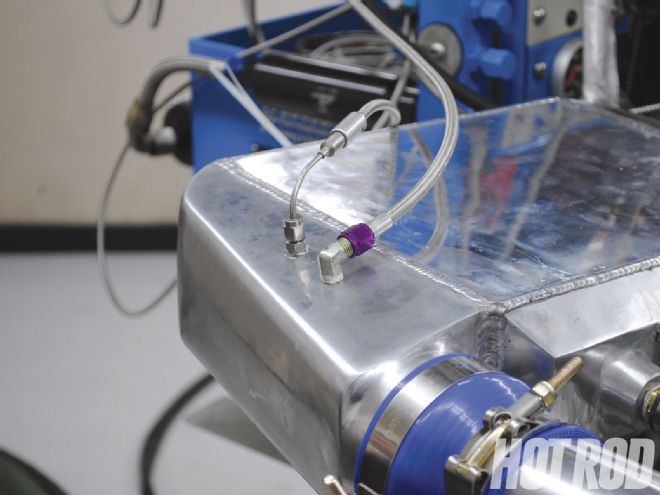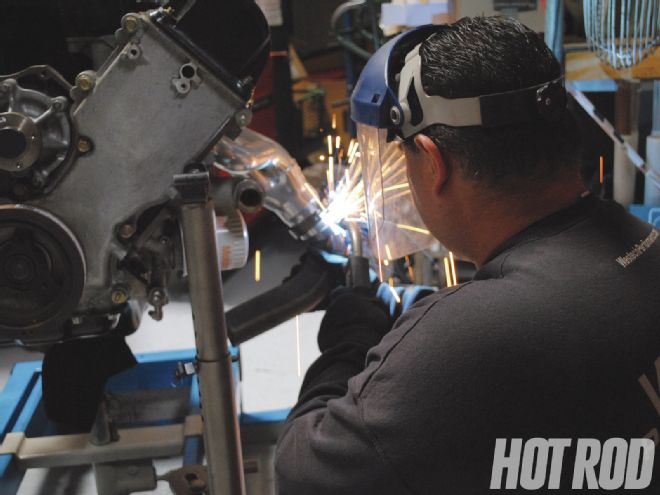
Our thought process was simpleif budget boost works for a Chevy, as we showed last month in the story 594 Horsepower For $3,252, then why not a late-model Ford? While Ford fans may argue the point, the GM LS engine family does have an advantage over the mod motor when it comes to power production, especially compared with the 4.6L two-valve. Designed as a replacement for the now-legendary 5.0L pushrod small-block, Ford’s 4.6L SOHC motor traded displacement for technology (or complexity, depending on your perspective). Unfortunately, the original 4.6L two-valve provided neither the torque of the original 5.0L nor the high-rpm power promised by the overhead-cam configuration. Ford eventually stepped up the performance of the two-valve when it introduced the Power Improved (PI) version in 1999, but a gain of 35 hp in 12 years could hardly be considered revolutionary, especially when GM was offering 5.7L combinations with nearly 100 more horsepower.
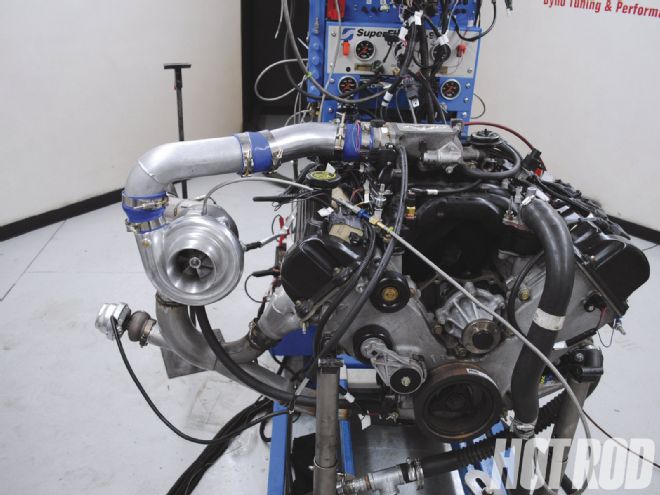 Our test would seem to indicate that the 4.6L motor and an eBay turbo are nothing less than a match made in dirt-cheap heaven.
Our test would seem to indicate that the 4.6L motor and an eBay turbo are nothing less than a match made in dirt-cheap heaven.
But don’t count out the two-valve, as the modular Ford still scores well on both price and availability. Like the 5.3L LS motor, the 4.6L two-valve was Ford’s official workhorse, offered in everything from trucks to Mustangs, and it started life way back in 1991 in the Lincoln Town Car. Despite the introduction of the three-valve and new four-valve 5.0L Coyote motor, the two-valve is still offered in a select few applications by Ford. With their 20-year production run, the chances of finding one in the wrecking yard are pretty good. Our local Pick-a-Part offered a complete, running modular motor with all accessories for just $265 plus core ($80), but that price was cut in half on select 50-percent-off sale weekends. We scored a complete running motor for the paltry sum of $135 plus the core at $80. Hard to go wrong for that kind of money, just make sure you do your homework and choose wisely.
We were lucky enough to find a PI motor from totaled ’99 Mustang GT, but plenty more were available in trucks and fullsize Fords (though most were of the non-PI variety). The extra 35 to 60 hp (depending on year and application) from the better heads on the PI motor will really come in handy, and that extra power offered in normally aspirated trim is multiplied by the boost pressure from a turbo. Adding 14.7 psi of boost to a motor can often double the normally aspirated power output. Doubling the power output of your 215hp non-PI mod motor equates to 430 hp, but doubling the power output of the 260hp PI motor equates to 520 hp (an extra 90 hp at the same boost). This is why adding the LS6 cam offered so much power on the turbocharged 5.3L last month. In reality, our 260hp PI test motor produced more than the rated 260 hp on the engine dyno, but that was simply a function of the test method. Regardless, every attempt should be made to increase the power output of the normally aspirated combination before adding boost.
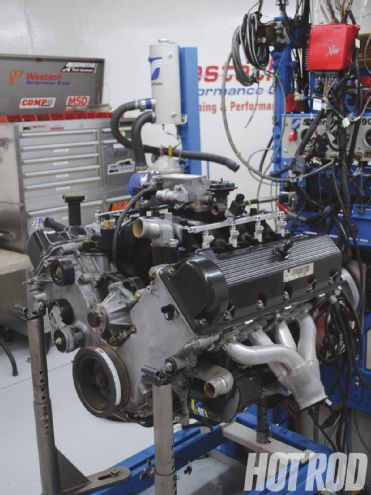 This stock 4.6L two-valve PI motor was yanked from the engine bay of a ’99 Mustang GT. Often overshadowed by the newer and more powerful 3V and 4V mod motors, the 2V combo is affordable, available, and potentially powerful. And though aftermarket components abound, our 4.6L remained completely stock, right down to the factory throttle-body and intake elbow, which are much less of a restriction when treated to positive pressure.
This stock 4.6L two-valve PI motor was yanked from the engine bay of a ’99 Mustang GT. Often overshadowed by the newer and more powerful 3V and 4V mod motors, the 2V combo is affordable, available, and potentially powerful. And though aftermarket components abound, our 4.6L remained completely stock, right down to the factory throttle-body and intake elbow, which are much less of a restriction when treated to positive pressure.
With our motor secured, we set to work on the turbo portion of the equation. Since it worked so well on our last test, we emulated the setup run on the 5.3L LS motor. A few changes to the basic system were in order for the 4.6L Ford, but a little eBay surfing netted a number of options, including a set of tubular exhaust manifolds designed for turbo use for only $100 and a killer water-to-air intercooler for $140. Unlike on the 5.3L test, we decided the $140 was money well spent on cooling the charge temperature. This ultimately allowed us to increase the boost pressure on the Ford, adding substantially more power.
Our 4.6L PI motor came complete, but there were still a few changes necessary before we could successfully run the turbo. First on the list was more fuel, as the stock, 19-pound injectors were not going to get the job done. We considered going old-school by employing an FMU (rising rate regulator) to increase the fuel pressure under boost, but precise tuning is difficult with this type of system. Besides, even a 12:1 increase in fuel pressure (versus boost) would only take us so far. In the end, we chose to purchase a set of 39-lb/hr FAST injectors from Summit Racing. The Ford Racing 42-pounders (as used on the 5.3L LS) might be an even better choice if you are looking for maximum power, but chances are you’ll damage the stock internals of the junkyard motor long before you run out of fuel flow. Just to be on the safe side, we cranked up the static fuel pressure on the 39-pound injectors (to 70 psi) and added a boost reference to the fuel pressure regulator on the engine dyno. Despite the fact that they looked healthy, we replaced the factory spark plugs with a set of NGK TR6 plugs (in a colder heat range). Before installation, the plug gap was reduced to just 0.028 inch in an effort to eliminate misfiring. On boosted applications, it is often necessary to employ an ignition amplifier, but our budget did not allow such extravagance. Removing a cam cover on our motor (something we did prior to the purchase) revealed super clean cylinder heads with no sign of wear or sludge. We suspect work had been performed on them sometime recently, and they appeared to have stock cams but nonstock valvesprings (a bonus for our turbo motor).
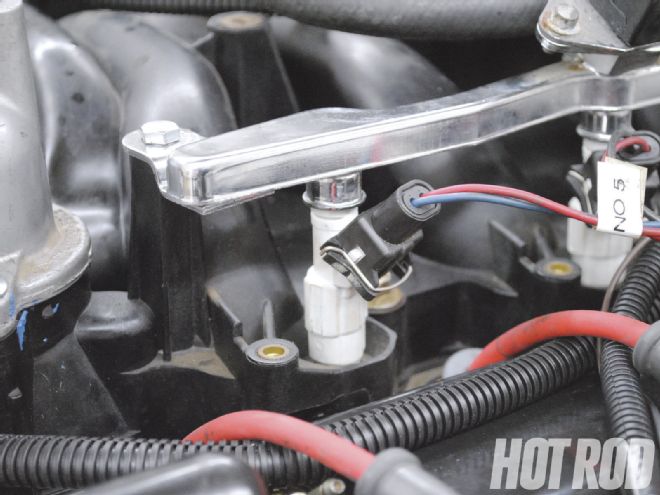 The factory 19-lb/hr injectors were woefully inadequate for a boosted motor approaching 600 hp, so we replaced them with a set of 39-pound FAST injectors from Summit Racing. Unlike the injectors, the flow rate of the factory fuel rail is more than enough at the desired power level.
The factory 19-lb/hr injectors were woefully inadequate for a boosted motor approaching 600 hp, so we replaced them with a set of 39-pound FAST injectors from Summit Racing. Unlike the injectors, the flow rate of the factory fuel rail is more than enough at the desired power level.
Though we included a complete wiring harness, ECU, and programming in the purchase price, we actually ran the motor on the dyno with a FAST XFI/XIM management system, which is not on the price list. The factory ECU can be tuned equally well using software from sources such as Diablo and SCT, but running on the engine dyno was quicker and easier with the FAST system. Prior to the final installation of the turbo, we ran the motor normally aspirated with a set of Kooks long-tube dyno headers to establish a baseline. Run as pulled from the wrecking yard, the 4.6L PI motor produced peak numbers of 296 hp at 4,900 rpm and 343 lb-ft at 4,100 rpm. That the motor produced more torque than horsepower is a clear indication that the long-runner induction and mild cam timing were tuned more for torque. As with the 5.3 LS, the 4.6L Ford responds very well to wilder cam timing (any of the XE cams from Comp make a sizable power difference). After the baseline, on went our homemade single-turbo kit featuring the 76mm turbo, but initially without the secret weapon: the air-to-water intercooler.
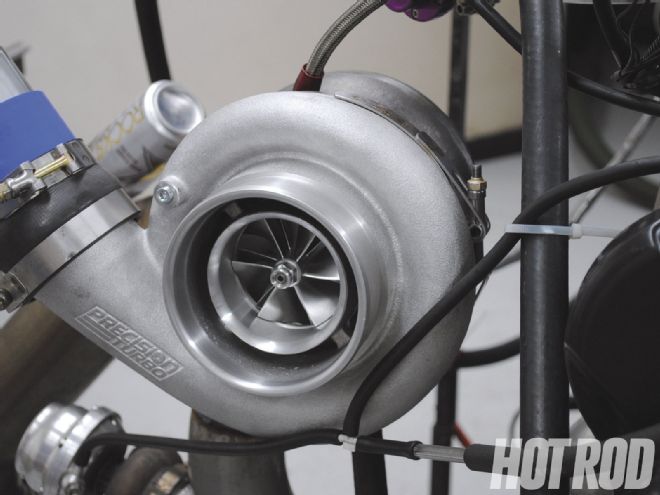 Since it worked so well on the 5.3L LS combination, we chose the same 76mm turbo (right down to the 0.96 A/R exhaust housing) from CX Racing. We also purchased a complete oil feed and drain kit that consisted of an aluminum feed fitting with oil restrictor (important on a mod motor producing as much as 100 psi of oil pressure). Also included in the kit were braided steel line with appropriate -4 fittings and an aluminum drain fitting. All that was required on our part was the purchase of a 5⁄8-inch steel fitting and matching 5⁄8-inch rubber hose to serve as the oil drain back to the pan.
Since it worked so well on the 5.3L LS combination, we chose the same 76mm turbo (right down to the 0.96 A/R exhaust housing) from CX Racing. We also purchased a complete oil feed and drain kit that consisted of an aluminum feed fitting with oil restrictor (important on a mod motor producing as much as 100 psi of oil pressure). Also included in the kit were braided steel line with appropriate -4 fittings and an aluminum drain fitting. All that was required on our part was the purchase of a 5⁄8-inch steel fitting and matching 5⁄8-inch rubber hose to serve as the oil drain back to the pan.
Wanting to start off our tuning at a lower boost level, we installed a 6-psi spring in the wastegate (an assortment was supplied with it), and the wastegate was adjusted using a manual controller from CX Racing. Not wanting to hurt the motor, we ran all of our testing on 100-octane Rocket Brand race fuel. The same combination could likely be run with 93-octane pump gas and a can of octane booster. The air/fuel ratio was kept near 11.8:1 while we experimented with different timing values, all below 20 degrees. The 4.6L did not respond well to either rich mixtures or low static timing. Running just 6 psi of boost, the motor produced 394 hp and 425 lb-ft of torque. Adding the intercooler to the mix resulted in a jump to 431 hp and 464 lb-ft of torque, while stepping up to 9.5 psi resulted in an even 500 hp and 533 lb-ft of torque. The final boost level of 14 psi brought 592 hp and 640 lb-ft of torque. Torque production from the little mod motor exceeded 600 lb-ft from 3,600 rpm to 5,100 rpm, making for an impressive torque curve.
 Since it worked so well on the 5.3L LS combination, we chose the same 76mm turbo (right down to the 0.96 A/R exhaust housing) from CX Racing. We also purchased a complete oil feed and drain kit that consisted of an aluminum feed fitting with oil restrictor (important on a mod motor producing as much as 100 psi of oil pressure). Also included in the kit were braided steel line with appropriate -4 fittings and an aluminum drain fitting. All that was required on our part was the purchase of a 5⁄8-inch steel fitting and matching 5⁄8-inch rubber hose to serve as the oil drain back to the pan.
Since it worked so well on the 5.3L LS combination, we chose the same 76mm turbo (right down to the 0.96 A/R exhaust housing) from CX Racing. We also purchased a complete oil feed and drain kit that consisted of an aluminum feed fitting with oil restrictor (important on a mod motor producing as much as 100 psi of oil pressure). Also included in the kit were braided steel line with appropriate -4 fittings and an aluminum drain fitting. All that was required on our part was the purchase of a 5⁄8-inch steel fitting and matching 5⁄8-inch rubber hose to serve as the oil drain back to the pan.
From all appearances, there was more power to be had from the 76mm turbo had we had the intestinal fortitude (or more accurately the lack of common sense) to push the boost higher than 14 psi on the stock motor. Though we are unsure how long some of these components might last, for now, this boneyard-boosted mod motor can be considered nothing but a success.
(Even before seeing the test results) How can an air-to-water intercooler this big, this shiny, and this heavy not be worth $140? The materials alone cost that much. Westech’s Ernie Mena
Expense Account
Item Source Cost 4.6L 2V motor Pick-A-Part $215 Core charge Pick-A-Part $80 Harness and ECU Pick-A-Part $130 SCT programmer SCT programmer $379 76mm turbo CX Racing $499 Tubular exhaust manifolds eBay $100 ATW intercooler CX Racing $140 3.0-inch tubing kit CX Racing $83 3.5-3.0-inch reducer (2) CX Racing $29 3.0-2.5-inch reducer CX Racing $0 3.0-inch couplers (2) CX Racing $0 3.0-inch clamps (7) CX Racing $0 2.5-inch clamps (2) CX Racing $0 3.5-inch clamps (2) CX Racing $0 Wastegate controller CX Racing $29 Oil feed & drain kit TRB-011-kit $30 60mm wastegate WG060-V-12 $99 Blow-off valve CX Racing $29 5 quarts Lucas oil Auto Zone $25 Oil filter Auto Zone $5 Fast 36-pound injectors Summit Racing $297 18 pipe to -4AN (straight) fitting G&J Fittings $4 18 pipe to -4AN (90) fitting G&J Fittings $5 Steel 58-inch pipe fitting (oil drain) G&J Fittings $2 2 feet of 58 heater hose (drain tube) Auto Zone $3 5 hose clamps (drain tube and intercooler) CX Racing $0 2.5-inch V-band clamp and fitting (2) CX Racing $19 T4 turbo flange FLNGT4 $19 90-degree mild steel bend (2) Muffler shop $12 2 feet of mild steel tubing Muffler shop $6 3-inch mild steel 90-degree bend Muffler shop $6 3-inch V-band clamp and fitting (exhaust) TRB-Vband300-kit-1-1 $29 3-inch 45-degree mild steel bend Muffler shop $0 Spark plugs Westech $24 Total
$2,298 Note: The $0 parts were thrown into the deal by CX Racing since the author bought so much stuff from them for this story.
The Price of Precision
How does the low-buck eBay turbo compare to the real deal? We found out by comparing our eBay unit to a 76mm turbo from Precision Turbo. Both are advertised as 76mm, but the configurations are quite different. The 76mm from Precision featured a larger compressor housing, turbine wheel, and A/R, along with a larger exhaust flange.

Despite the 76mm ratings (which indicates the size of the inducer), the difference in power might come as much from the different specs as things like the quality and design of the compressor wheels. A back-to-back test netted a solid 46 hp in favor of the Precision unit, with 14 psi producing an amazing 638 hp and 665 lb-ft. Not only was the power up, but the intercooler inlet temp was down nearly 25 degrees. The gains could be even more substantial at higher boost and power levels, and the 76mm Precision Turbo will support more than 900 hp. Now the bad news: a 76mm ball-bearing turbo from Precision can run as much as $2,500, depending on configuration (but you definitely get what you pay for).
Intercooler Efficiency
It’s hard to argue with an air-to-water intercooler that costs just $140, especially a polished-aluminum piece that included brass water fittings and aluminum mounting flanges. Every turbo guy we showed the core to wanted one based on looks and price alone (to say nothing of the physical weightit just felt like it was worth way more than $140). External appearances aside, how well did it really work? To find out, we plumbed the intercooler during our testing to data-log both the pressure and temperature drop across the core. Advertised by CX Racing to support as much as 1,500 hp, the intercooler featured a big 12x10x4.75-inch core. Available both with and without a secondary heat exchanger, the core seemed (if anything) oversized for our needs. Data gathered during the dyno testing indicated that the inlet temps into the motor never exceeded 95 degrees using 74-degree cooling water, this despite temperatures ranging from 188 to 212 degrees entering the core. This indicates that the core had plenty of reserve cooling capacity. Making things even better was the fact that this cooling came with a drop in boost pressure of less than 1 psi across the core. It was $140 well spent indeed. HRM
